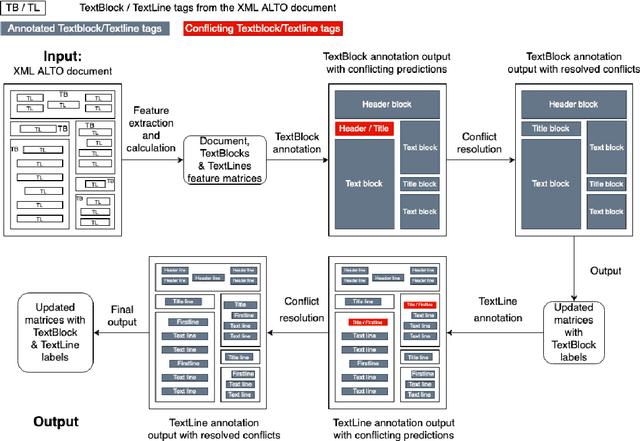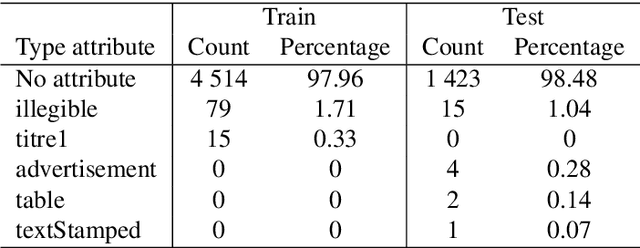Iana Atanassova
CRIT, STIH, TESNIERE, LaLIC
Annotating Scientific Uncertainty: A comprehensive model using linguistic patterns and comparison with existing approaches
Mar 14, 2025Abstract:UnScientify, a system designed to detect scientific uncertainty in scholarly full text. The system utilizes a weakly supervised technique to identify verbally expressed uncertainty in scientific texts and their authorial references. The core methodology of UnScientify is based on a multi-faceted pipeline that integrates span pattern matching, complex sentence analysis and author reference checking. This approach streamlines the labeling and annotation processes essential for identifying scientific uncertainty, covering a variety of uncertainty expression types to support diverse applications including information retrieval, text mining and scientific document processing. The evaluation results highlight the trade-offs between modern large language models (LLMs) and the UnScientify system. UnScientify, which employs more traditional techniques, achieved superior performance in the scientific uncertainty detection task, attaining an accuracy score of 0.808. This finding underscores the continued relevance and efficiency of UnScientify's simple rule-based and pattern matching strategy for this specific application. The results demonstrate that in scenarios where resource efficiency, interpretability, and domain-specific adaptability are critical, traditional methods can still offer significant advantages.
Understanding Archives: Towards New Research Interfaces Relying on the Semantic Annotation of Documents
Mar 28, 2024Abstract:The digitisation campaigns carried out by libraries and archives in recent years have facilitated access to documents in their collections. However, exploring and exploiting these documents remain difficult tasks due to the sheer quantity of documents available for consultation. In this article, we show how the semantic annotation of the textual content of study corpora of archival documents allow to facilitate their exploitation and valorisation. First, we present a methodological framework for the construction of new interfaces based on textual semantics, then address the current technological obstacles and their potential solutions. We conclude by presenting a practical case of the application of this framework.
Distantly Supervised Morpho-Syntactic Model for Relation Extraction
Jan 18, 2024



Abstract:The task of Information Extraction (IE) involves automatically converting unstructured textual content into structured data. Most research in this field concentrates on extracting all facts or a specific set of relationships from documents. In this paper, we present a method for the extraction and categorisation of an unrestricted set of relationships from text. Our method relies on morpho-syntactic extraction patterns obtained by a distant supervision method, and creates Syntactic and Semantic Indices to extract and classify candidate graphs. We evaluate our approach on six datasets built on Wikidata and Wikipedia. The evaluation shows that our approach can achieve Precision scores of up to 0.85, but with lower Recall and F1 scores. Our approach allows to quickly create rule-based systems for Information Extraction and to build annotated datasets to train machine-learning and deep-learning based classifiers.
UnScientify: Detecting Scientific Uncertainty in Scholarly Full Text
Jul 26, 2023Abstract:This demo paper presents UnScientify, an interactive system designed to detect scientific uncertainty in scholarly full text. The system utilizes a weakly supervised technique that employs a fine-grained annotation scheme to identify verbally formulated uncertainty at the sentence level in scientific texts. The pipeline for the system includes a combination of pattern matching, complex sentence checking, and authorial reference checking. Our approach automates labeling and annotation tasks for scientific uncertainty identification, taking into account different types of scientific uncertainty, that can serve various applications such as information retrieval, text mining, and scholarly document processing. Additionally, UnScientify provides interpretable results, aiding in the comprehension of identified instances of scientific uncertainty in text.
Processing the structure of documents: Logical Layout Analysis of historical newspapers in French
Feb 16, 2022



Abstract:Background. In recent years, libraries and archives led important digitisation campaigns that opened the access to vast collections of historical documents. While such documents are often available as XML ALTO documents, they lack information about their logical structure. In this paper, we address the problem of Logical Layout Analysis applied to historical documents in French. We propose a rule-based method, that we evaluate and compare with two Machine-Learning models, namely RIPPER and Gradient Boosting. Our data set contains French newspapers, periodicals and magazines, published in the first half of the twentieth century in the Franche-Comt\'e Region. Results. Our rule-based system outperforms the two other models in nearly all evaluations. It has especially better Recall results, indicating that our system covers more types of every logical label than the other two models. When comparing RIPPER with Gradient Boosting, we can observe that Gradient Boosting has better Precision scores but RIPPER has better Recall scores. Conclusions. The evaluation shows that our system outperforms the two Machine Learning models, and provides significantly higher Recall. It also confirms that our system can be used to produce annotated data sets that are large enough to envisage Machine Learning or Deep Learning approaches for the task of Logical Layout Analysis. Combining rules and Machine Learning models into hybrid systems could potentially provide even better performances. Furthermore, as the layout in historical documents evolves rapidly, one possible solution to overcome this problem would be to apply Rule Learning algorithms to bootstrap rule sets adapted to different publication periods.
Editorial for the First Workshop on Mining Scientific Papers: Computational Linguistics and Bibliometrics
Jun 17, 2015Abstract:The workshop "Mining Scientific Papers: Computational Linguistics and Bibliometrics" (CLBib 2015), co-located with the 15th International Society of Scientometrics and Informetrics Conference (ISSI 2015), brought together researchers in Bibliometrics and Computational Linguistics in order to study the ways Bibliometrics can benefit from large-scale text analytics and sense mining of scientific papers, thus exploring the interdisciplinarity of Bibliometrics and Natural Language Processing (NLP). The goals of the workshop were to answer questions like: How can we enhance author network analysis and Bibliometrics using data obtained by text analytics? What insights can NLP provide on the structure of scientific writing, on citation networks, and on in-text citation analysis? This workshop is the first step to foster the reflection on the interdisciplinarity and the benefits that the two disciplines Bibliometrics and Natural Language Processing can drive from it.
Mining Scientific Papers for Bibliometrics: a (very) Brief Survey of Methods and Tools
May 06, 2015Abstract:The Open Access movement in scientific publishing and search engines like Google Scholar have made scientific articles more broadly accessible. During the last decade, the availability of scientific papers in full text has become more and more widespread thanks to the growing number of publications on online platforms such as ArXiv and CiteSeer. The efforts to provide articles in machine-readable formats and the rise of Open Access publishing have resulted in a number of standardized formats for scientific papers (such as NLM-JATS, TEI, DocBook). Our aim is to stimulate research at the intersection of Bibliometrics and Computational Linguistics in order to study the ways Bibliometrics can benefit from large-scale text analytics and sense mining of scientific papers, thus exploring the interdisciplinarity of Bibliometrics and Natural Language Processing.
 Add to Chrome
Add to Chrome Add to Firefox
Add to Firefox Add to Edge
Add to Edge